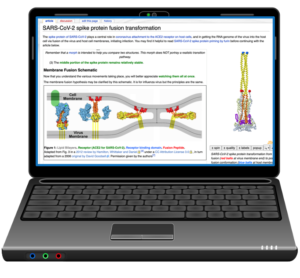Open Access Week 2020: Highlighting Open Educational Resources

By Tierney Gleason, Reference and Digital Humanities Librarian, and Jeannie Hoag, Reference and Assessment Librarian
In recognition of Open Access Week 2020, we’re giving a shoutout to Open Educational Resources, or OER. For faculty, these open digital resources can help ease the stress of developing online course content from scratch. For students, OER can support their success by reducing the cost of course materials.
What is an OER?
Open educational resources (OER) are teaching, learning, and research materials in any medium that reside in the public domain or that have been released under an open license that permits no-cost access, use, adaptation, and redistribution by others. OER confer significant dollar savings while also giving learners ready access to a wide range of high-quality, highly flexible educational materials. Open content offers faculty a means to customize curriculum to better align with learner needs and interests and to collaborate in new ways with peers worldwide. – “7 Things You Should Know About Open Education: Content” from EDUCAUSE
This definition translates into a variety of digital materials ranging from textbooks, tutorials, educational games, scientific simulations, syllabi, digital collections, and more.

Why Use OER?
Since OER are digital, free to use, AND shared under Creative Commons licenses, they can be edited to create modules on a topic or remixed and adapted in full to meet the specific needs of a course. This opens endless possibilities to be in conversation about pedagogy with other professors and instructors who create OER while saving time by curating content rather than creating brand new materials for the flexible hybrid learning environment. (Hat tip to “Curate, Don’t Create: Online Courses As Instructional Exhibits” by Fordham’s Director of Online Learning, Steven D’Agustino.)
For students, the main advantage of OER course materials or full textbooks is their cost. However, a study published in 2018 from the Center for Teaching and Learning at the University of Georgia argued that using OER improved affordability as well as end-of-course grades, completion, and attainment gap concerns among their students. While more research on the overall impact of OER is needed, preliminary data presents them as sound choices for course adoption where issues of affordability and retention are concerned.
How Can I Use OER?

Like all forms of scholarship, all that is needed (besides creativity, a computer, and an internet connection) to adapt OER is proper citation. On the Open Educational Resources (OER) tab of the Copyright Resources research guide, Fordham librarians have listed a set of resources to help guide our research community through interpreting Creative Commons licenses and formatting attributions in compliance with copyright guidelines.
Where Can I Find OER?

Fordham librarians have curated a list of websites showcasing different types of OER and/or open access materials. To limit your search to textbooks only, Open Textbook Library, BCcampus Open Ed, and OpenStax are great options. For more expansive searches of open materials including textbooks as well as syllabi, educational games, simulations, tutorials and more, try MERLOT, OASIS, and OER Commons. Each website allows different options to limit searches by subject, educational level, content type, and more. Additionally, many of these open resources are peer-reviewed as well as provide options for you to join the conversation and submit a review.
We should note, however, that accessibility varies on an individual basis with OER. Some titles or platforms are not compatible with all devices or operating systems, and not all OER are designed with users who need screen readers or other forms of assistive technology in mind. Please reach out to the library with questions about the web accessibility of OER or consult our growing Web Accessibility at Fordham University Libraries research guide.
Interested in OER?
If you’re interested in using OER or other types of open access resources for your courses, contact the library liaison for your department or program. We’re happy to direct you to possible resources to meet your disciplinary needs. If you are looking for a locally-produced OER that explains academic research to your students, try using the Library Tutorial. Each module was designed to teach Fordham students how to use library resources and evaluate information.


